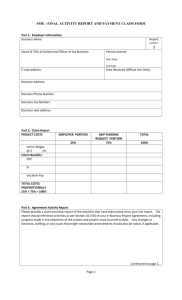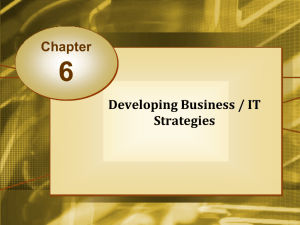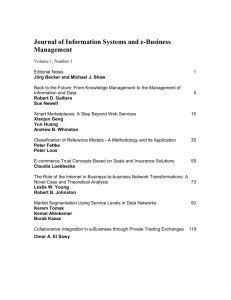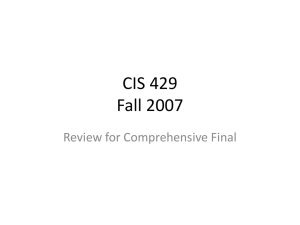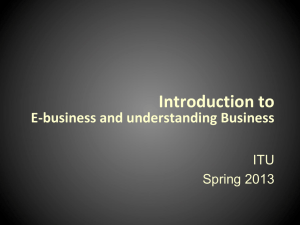Chapter 7 Developing E Business Strategies
advertisement
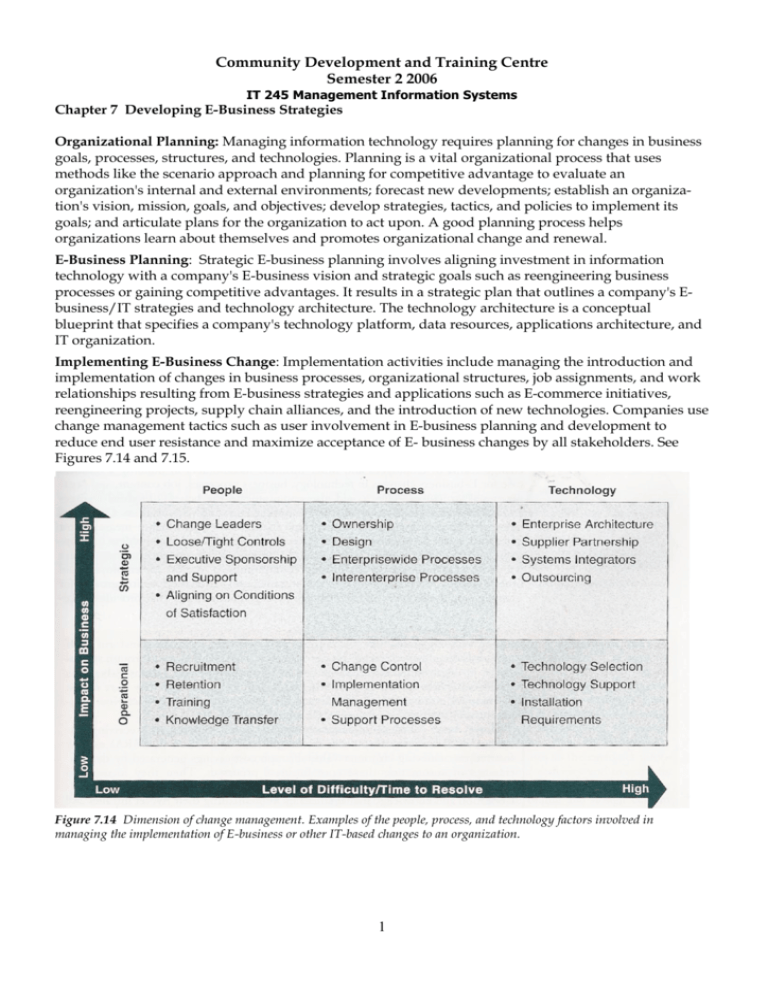
Community Development and Training Centre Semester 2 2006 IT 245 Management Information Systems Chapter 7 Developing E-Business Strategies Organizational Planning: Managing information technology requires planning for changes in business goals, processes, structures, and technologies. Planning is a vital organizational process that uses methods like the scenario approach and planning for competitive advantage to evaluate an organization's internal and external environments; forecast new developments; establish an organization's vision, mission, goals, and objectives; develop strategies, tactics, and policies to implement its goals; and articulate plans for the organization to act upon. A good planning process helps organizations learn about themselves and promotes organizational change and renewal. E-Business Planning: Strategic E-business planning involves aligning investment in information technology with a company's E-business vision and strategic goals such as reengineering business processes or gaining competitive advantages. It results in a strategic plan that outlines a company's Ebusiness/IT strategies and technology architecture. The technology architecture is a conceptual blueprint that specifies a company's technology platform, data resources, applications architecture, and IT organization. Implementing E-Business Change: Implementation activities include managing the introduction and implementation of changes in business processes, organizational structures, job assignments, and work relationships resulting from E-business strategies and applications such as E-commerce initiatives, reengineering projects, supply chain alliances, and the introduction of new technologies. Companies use change management tactics such as user involvement in E-business planning and development to reduce end user resistance and maximize acceptance of E- business changes by all stakeholders. See Figures 7.14 and 7.15. Figure 7.14 Dimension of change management. Examples of the people, process, and technology factors involved in managing the implementation of E-business or other IT-based changes to an organization. 1 Figure 7.15 The process of change management. Examples of the activities involved in successfully managing organizational change caused by the implementation of E-business strategies. Key Terms and Concepts These are the key terms and concepts of this chapter. 1. Change management 2. E-business planning a. Application planning b. Architecture planning 3. End user involvement 4. End user resistance 5. Implementation 6. Implementing E-business change 7. 8. Information technology architecture Organizational planning 9. Planning for competitive advantage 10. 11. Scenario approach to planning SWOT analysis 2 c. Strategic planning Review Quiz Match one of the key terms and concepts listed previously with one of the brief examples or definitions that follow. Try to find the best fit for answers that seem to fit more than one term or concept. Defend your choices. 1. An organization should create a shared business vision and mission, and plan how it will achieve its strategic goals and objectives. 2. Outlines an E-business vision, E-business/IT strategies, and technical architecture for a company. 3. A blueprint for information technology in a company that specifies a technology platform, applications architecture, data resources, and IT organization structure. 4. Evaluating strategic E-business opportunities based on their risk/payoff potential for a company. 5. 6. 7. Planning teams simulate the role of information technology in various hypothetical business situations. Evaluating IT proposals for new E-business application development projects. Evaluating strategic E-business opportunities based on a company's capabilities and the competitive environment. Accomplishing the strategies and applications developed during organizational planning. Implementing new E-business strategies and applications within a company. End users frequently resist the introduction of new technology. End users should be part of planning for organizational change and E-business project teams. Companies should try to minimize the resistance and maximize the acceptance of major changes in Ebusiness and information technology. 8. 9. 10. 11. 12. Discussion Questions 1. Planning is a useless endeavor, because developments in E-business and E-commerce, and in the political, economic, and societal environment are moving too quickly nowadays. Do you agree or disagree with this statement? Why? 2. “Planning and budgeting processes are notorious for their rigidity and irrelevance to management action." How can planning be made relevant to the challenges facing an E-business enterprise? 3. Refer to the Real World Case on Accel Partners in the chapter. What new technologies do you think companies should include in their E-business and E-commerce planning? Give several examples and explain the possible impact of one of them. 4. What planning methods would you use to develop E-business and E-commerce strategies and applications for your own business? Explain your choices. 5. What are several E-business and E-commerce strategies and applications that should be developed and implemented by many companies today? Explain your reasons. Refer to the Real World Case on Cross Engineering, Pitney- Bowes, and Emerson in the chapter. "The Internet changes how we interface with the customer, how we manage internally. . ." What are several implications of this statement for E-business planning? 6. 7. 8. How can a company use change management to minimize the resistance and maximize the acceptance of changes in business and technology? Give several examples. "Many companies plan really well, yet few translate strategy into action." Do you think this statement is true? Why or why not? 9. Review the real world examples on end user resistance to knowledge management (Context Integration) and customer relationship management (Automated Data Processing) in the chapter. What else would you recommend to encourage user acceptance in both cases? Explain your recommendations. 10. What major business changes beyond E-business and Ecommerce do, you think most companies should be planning for in the next ten years? Explain your choices. 3



